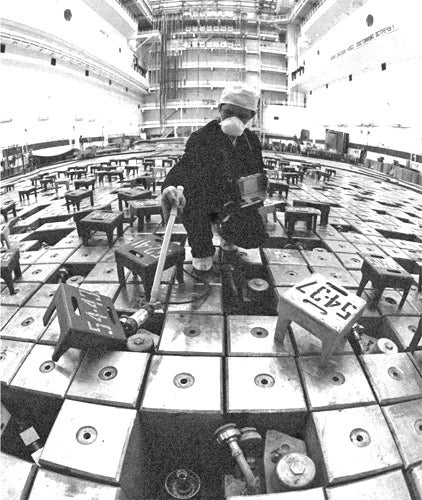The clean-up crews who risk everything
As thousands flee the reactors, some workers are trying to fix them

Your support helps us to tell the story
From reproductive rights to climate change to Big Tech, The Independent is on the ground when the story is developing. Whether it's investigating the financials of Elon Musk's pro-Trump PAC or producing our latest documentary, 'The A Word', which shines a light on the American women fighting for reproductive rights, we know how important it is to parse out the facts from the messaging.
At such a critical moment in US history, we need reporters on the ground. Your donation allows us to keep sending journalists to speak to both sides of the story.
The Independent is trusted by Americans across the entire political spectrum. And unlike many other quality news outlets, we choose not to lock Americans out of our reporting and analysis with paywalls. We believe quality journalism should be available to everyone, paid for by those who can afford it.
Your support makes all the difference.As the Japanese government widens the exclusion zone around the Fukushima plant, it is worth remembering that not everyone is able to remain indoors or leave the area. The workers dealing with the crisis have a monumental responsibility – which could leave them with lifelong health problems, or even kill them.
After most emergency workers were evacuated yesterday, about 50 remained inside the plant. They have had to perform emergency tasks in extremely difficult conditions – battling to keep the nuclear reactors from entering meltdown and fighting off outbreaks of fire. Dressed in protective gear, they have had to pump seawater into the failing reactors to try to keep them cool, and all their work has been carried out in conditions of escalating radiation.
"I'm fairly sure the workers inside are being subjected to high levels of radiation," said Rianne Teule, an anti-nuclear campaigner for Greenpeace. "The information we have is they are working in 15-minute shifts to reduce exposure."
Japanese authorities have not released information about maximum doses of radiation workers will be exposed to, or whether they will be replaced. But with a finite pool of workers available, unless the problem is brought under control, they will ultimately be exposed to dangerous doses – or the work will be abandoned. There was speculation yesterday that volunteers from other plants and retirees might be called in.
Such calculations are familiar to those who worked at Chernobyl, site of the worst nuclear accident in history in 1986, when reactor number four exploded. After that catastrophe, a volunteer group of older experts travelled to the site to offer their help, on the principle that the longer-term consequences such as cancers, which emerge many years later, would matter less to them. In the immediate aftermath of the disaster, the earliest responders, such as the local firemen, were exposed to doses of radiation so large that many of them died within weeks. Later, the Soviet authorities flew in hundreds of thousands of workers to aid the clean-up operation. Some of them worked for as little as 15 seconds before they had reached the maximum dose and were sent home.
As the 25th anniversary of the Chernobyl disaster approaches next month, work is still under way to make the remains of reactor number four safe. Conditions inside the destroyed reactor are still so bad that there are rooms workers can only enter for a few seconds.
"There's a regular maximum dose per year in every country, and once the Japanese workers get that, they should be sent home," Laurin Dodd, an American nuclear specialist currently leading the shelter project at Chernobyl, told The Independent by telephone from the site of the reactor yesterday. "You can also bring in one-time exceptions where people exceed the maximum dose."
The workers will all be wearing breathing masks and protective suits, but there is nothing which can protect against radiation completely. Wearing suits made of lead can further reduce exposure, but the weight means work is done more slowly, so the overall effect is dubious.
Experts said it was still difficult to tell just how serious the situation inside the reactor was, but it is already clear radiation levels inside will be significantly higher than outside, so workers will be putting themselves at risk.
"There's definitely a risk not just of long-term health effects, but a possibility they could get sick immediately," said Ms Teule of Greenpeace.
Mr Dodd agreed workers could be at risk, but said the scale of the disaster was considerably smaller than at Chernobyl. Even if there is a breach of the containers and nuclear material escapes, the consequences will be less severe.
Join our commenting forum
Join thought-provoking conversations, follow other Independent readers and see their replies
Comments